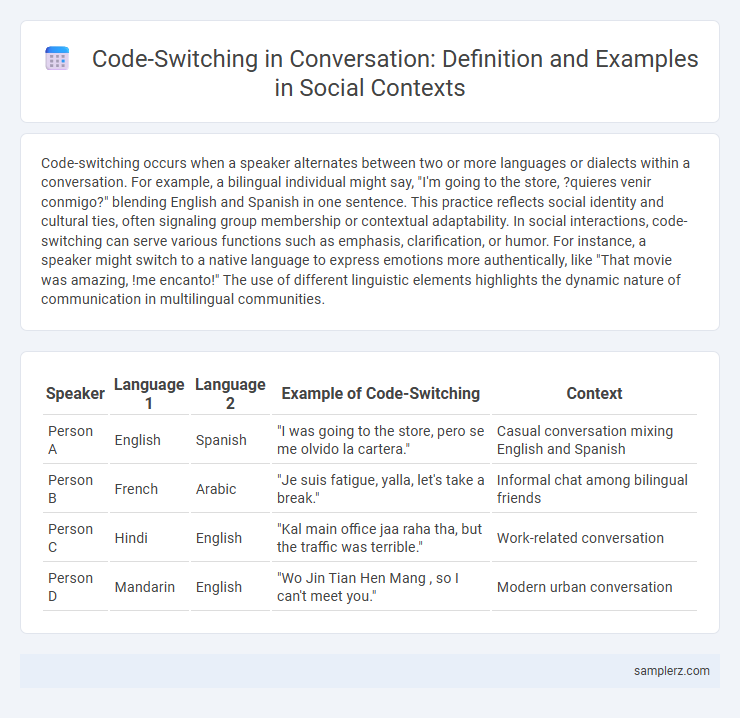Code-switching occurs when a speaker alternates between two or more languages or dialects within a conversation. For example, a bilingual individual might say, "I'm going to the store, ?quieres venir conmigo?" blending English and Spanish in one sentence. This practice reflects social identity and cultural ties, often signaling group membership or contextual adaptability. In social interactions, code-switching can serve various functions such as emphasis, clarification, or humor. For instance, a speaker might switch to a native language to express emotions more authentically, like "That movie was amazing, !me encanto!" The use of different linguistic elements highlights the dynamic nature of communication in multilingual communities.
Table of Comparison
| Speaker | Language 1 | Language 2 | Example of Code-Switching | Context |
|---|---|---|---|---|
| Person A | English | Spanish | "I was going to the store, pero se me olvido la cartera." | Casual conversation mixing English and Spanish |
| Person B | French | Arabic | "Je suis fatigue, yalla, let's take a break." | Informal chat among bilingual friends |
| Person C | Hindi | English | "Kal main office jaa raha tha, but the traffic was terrible." | Work-related conversation |
| Person D | Mandarin | English | "Wo Jin Tian Hen Mang , so I can't meet you." | Modern urban conversation |
Everyday Conversations: Code-Switching in Multilingual Homes
In multilingual homes, code-switching often occurs naturally during everyday conversations, such as parents blending English and Spanish while discussing daily routines or children switching between languages when sharing stories with siblings. This dynamic linguistic behavior enhances communication by allowing speakers to express cultural identity and convey nuanced meanings effectively. Frequent code-switching in such settings reflects the fluid integration of multiple languages within family interactions.
Code-Switching Among Friends: Navigating Social Circles
Code-switching among friends often involves seamlessly alternating between languages or dialects to convey shared cultural identity and strengthen social bonds. This practice fosters inclusivity within diverse social circles by adapting communication styles to match the group's linguistic norms. Examples include shifting from formal language to slang or mixing languages like Spanglish, reflecting fluid social dynamics and identity negotiation.
Identity and Code-Switching in Peer Interactions
Code-switching in peer interactions often reflects shifts in social identity to align with group norms or assert membership within diverse communities. For example, a bilingual teenager might switch from English to Spanish when sharing cultural experiences with close friends, signaling in-group solidarity and cultural pride. Such linguistic adaptation functions as a dynamic tool for navigating social identities and fostering interpersonal connections.
Code-Switching in the Workplace: Professional vs. Casual Speech
Code-switching in the workplace often involves shifting between professional language, such as formal vocabulary and industry-specific jargon, and casual speech that includes slang or colloquialisms when interacting with colleagues. Employees might use professional speech during meetings or presentations to convey expertise, then switch to informal language in break rooms or casual chats to build rapport. This dynamic adjustment helps navigate social norms and fosters effective communication in diverse work environments.
Navigating Cultural Boundaries: Code-Switching at Social Gatherings
Code-switching at social gatherings often involves alternating between languages or dialects to navigate cultural boundaries and foster inclusivity. For example, a bilingual speaker might switch from Spanish to English when addressing a diverse group, signaling respect and shared identity. This practice enhances communication efficacy by bridging cultural norms and social expectations within multicultural environments.
Online Messaging: Digital Code-Switching Examples
Online messaging often features digital code-switching, where users blend formal language with slang or emojis to convey tone and intent. For example, a message might read, "Hey, are you coming to the mtg? " seamlessly mixing abbreviations and emoticons for brevity and emotional clarity. This evolving communication style reflects adaptive language use in virtual social interactions.
Generational Differences: Youth Code-Switching with Parents
Younger generations often switch between informal slang and formal language when speaking with their parents to navigate respect and relatability. This code-switching reflects cultural and emotional flexibility, balancing peer group identity with family expectations. Patterns include mixing regional dialects with standard language to maintain connection while asserting individuality.
Humor and Code-Switching: Using Language for Social Bonding
Humor and code-switching often merge in conversations where speakers alternate between languages or dialects to create playful, relatable interactions that strengthen social bonds. For example, a bilingual friend might switch to a shared cultural phrase or slang mid-joke, amplifying laughter and inclusivity within the group. This dynamic use of language not only entertains but also signals group identity and emotional connection.
Public vs. Private: Code-Switching in Community Events
Community events often prompt code-switching between public and private speech styles, where speakers alternate languages or dialects to align with social norms or express group identity. For instance, a bilingual individual might use formal English in public announcements but switch to a native language when engaging with close friends or family nearby. This dynamic reflects how code-switching functions as a tool for navigating social boundaries and reinforcing community bonds.
Code-Switching in Educational Settings: Teacher-Student Dialogue
Code-switching in educational settings often occurs when teachers alternate between the dominant language and students' native languages to enhance comprehension and engagement. For example, a teacher might explain a complex scientific concept in English, then switch to Spanish to clarify key terms for bilingual students, fostering better understanding. This strategic language use supports cognitive development and bridges linguistic gaps in diverse classrooms.

example of code-switching in conversation Infographic
 samplerz.com
samplerz.com